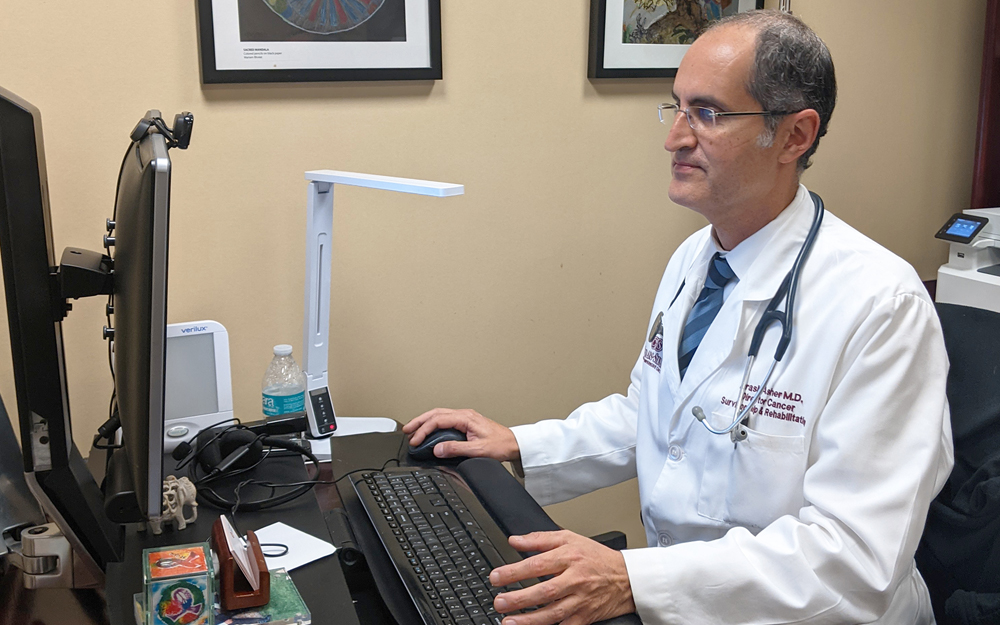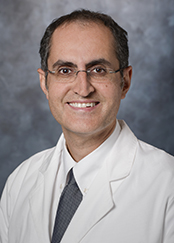Cedars-Sinai Blog
Cancer Patients Find New Ways to Connect Virtually During COVID-19
Jun 07, 2021 Rosanna Turner

Undergoing treatment for cancer can be tough physically, mentally and emotionally. In 2020, cancer patients at Cedars-Sinai had to face a new challenge: getting treatment during the COVID-19 pandemic.
"There's something comforting about being in your pajamas and in your own home environment. There was also a tremendous amount of comfort in having a way for cancer patients to stay connected during this time."

Dr. Arash Asher
"At the beginning of the pandemic, some cancer patients felt a huge loss of support," says Dr. Arash Asher, director of Cancer Rehabilitation and Survivorship at Cedars-Sinai. "It was a whole new experience, not being able to have a loved one or spouse sit with you during infusion treatments due to COVID-19 restrictions, and also not being able to attend in-person support groups."
Creating community among cancer patients
For more than a decade, Cedars-Sinai has offered Wellness, Resilience and Survivorship programs to our cancer patients. When he joined Cedars-Sinai, Dr. Asher saw a need for supportive and rehabilitative programs tailored specifically for cancer patients.
"There weren't just one or two patients going through this—it was always a cohort of people struggling with the same things," Dr. Asher says. "I thought it would be great to get these people together in a group, while trying to create a sense of comradery and community among cancer patients."
Staying connected virtually
Prior to the pandemic, all programs for cancer patients and cancer survivors were held in-person at Cedars-Sinai. In March 2020, when the city of Los Angeles enacted its first COVID-19 stay-at-home orders, the survivorship programs moved to a virtual format.
"In the beginning we had no idea what we were doing," Dr. Asher says. "I had no idea how to use Zoom, WebEx and all these other platforms. But where there's a need, there's a way, and we just figured it out."
For some, the option of a virtual cancer support program was a benefit. Patients who lived far from the medical campus could now log on and join from anywhere, without having to deal with the hassle of traffic or parking.
"There's something comforting about being in your pajamas and in your own home environment," Dr. Asher says. "There was also a tremendous amount of comfort in having a way for cancer patients to stay connected during this time."
Getting diagnosed with cancer during the pandemic
Cedars-Sinai patient Sharon Lippman, 72, was diagnosed with breast cancer in February 2020. Sharon has a family history of the disease: Both her mother and grandmother had breast cancer.
"When I was having my biopsy, I was so sad just thinking about my grandmother, because she passed away from breast cancer," Sharon says.
In 2012, Sharon had undergone testing for the BRCA1 and BRCA2 genes, along with an additional genetic test, but all tests came back negative.
"Everybody was wondering, 'How did you get breast cancer?'" Sharon says. "But it's not just me. I know of many other women with breast cancer who didn't have any positive gene test before getting diagnosed."
Confronting cancer and COVID-19 fears
After undergoing a lumpectomy in March 2020, Sharon continued her cancer treatment with multiple rounds of chemotherapy, followed by radiation.
As someone who was at high risk for breast cancer for much of her life, Sharon had often thought about what might happen if she got diagnosed. However, she never anticipated having to undergo many months of cancer treatment during a pandemic.
"Many patients were scared, because they saw themselves as higher risk for COVID-19," Dr. Asher says. "It was understandably quite distressing and another thing they had to contend with during treatment."
However, the coping strategies that patients use while in cancer treatment, which typically lasts six to 12 months, has also helped them navigate the pandemic.
"Some of the things cancer patients have to learn—such as overcoming and managing fear, dealing with the unknown—you can borrow them and use for other life circumstances," Dr. Asher says.
Virtual exercise programs tailored to cancer patients
After finishing her cancer treatments in the fall of 2020, Sharon signed up for the Cancer Exercise Recovery Program at Cedars-Sinai, a 12-week program that was held virtually.
"Chemotherapy causes bone loss and muscle deterioration," Sharon says. "I liked that this whole program was designed for me specifically."
Sharon worked with a personal trainer three times a week over Zoom.
"I really thrived with exercise," Sharon says. "I improved tremendously from it. With chemotherapy you also lose balance, and I noticed my balance improved."
Knowing you're not alone during recovery
Sharon also participated in Emerging from the Haze™️, an educational program for cancer patients run by Dr. Asher. Sharon says that the virtual program helped her better understand health issues she might experience while recovering from cancer treatment, such as brain fog, depression, changes in diet and difficulty sleeping.
"I also learned that when you're recovering from cancer treatment, don't be so hard on yourself, and there are many others going through the same situation," Sharon says. "The programs are excellent."
Read: What Is Chemo Brain?
Finding new ways to support cancer patients
In the future, Dr. Asher hopes to offer a hybrid model for some of the Wellness, Resilience and Survivorship programs at Cedars-Sinai, with a mix of in-person and virtual sessions.
"There's no substitute for the in-person connection and sense of community that's created when we all gather together for the support programs," Dr. Asher says. "The pivot to virtual classes wasn't perfect, but it worked out better than we thought."


